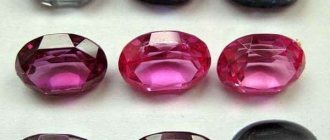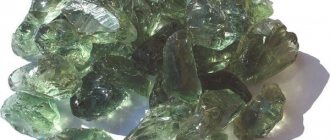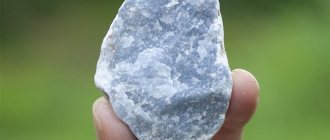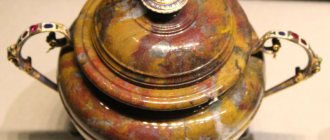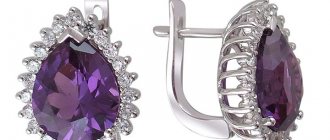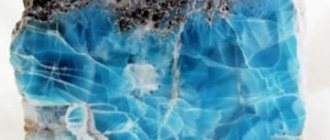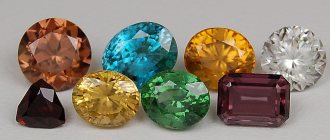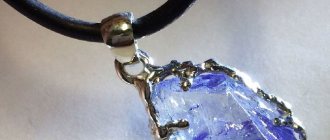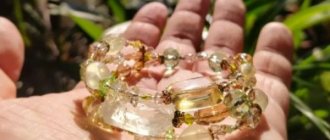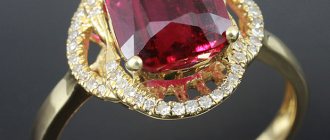Story
The stone was introduced to Russia and Europe in the 16th century by merchants who brought it from India.
Kyanite is one of the few minerals whose names are known exactly:
- 1789 The German geologist and mineralogist Abraham Werner, without further ado, dubbed it kyanos (κυανός in Greek means “blue”). Although in its homeland it was a “plank stone”: a long crystal-column in shape and texture really looks like a piece of board.
- His French colleague René Haüy, taking into account the duality in the formation of crystals, coined the term “ dysthene ” - “dis sthenos” (“double strength”) in Greek.
- In Rus', the mineral was known as “baus” - named after Jeremiah Baus. This London merchant specialized in precious stones during the reign of Ivan the Terrible. At that time, almost all precious stones were called bausses.
Among gemologists and collectors, the terms kyanite, reticite, xantholite, beryl-azul (that is, blue beryl), sapphire spar, cyanite are in use.
Nepalese kyanite, cut into oval shape
Well-polished blue kyanite was passed off as sapphire five centuries ago.
Physico-chemical characteristics
To a chemist, the mineral kyanite is an aluminum silicate. The second main component of the formula is silicon oxide.
| Formula | Al2O(SiO4) |
| Color | Blue, green, yellow, violet, colorless, black |
| Stroke color | White |
| Shine | Glass (pearl) |
| Transparency | Transparent, translucent |
| Hardness | 4—7 |
| Cleavage | Perfect by {100} |
| Kink | Splintered |
| Density | 3.56—3.67 g/cm³ |
| singonia | Triclinic |
| Refractive index | 1,72 |
A couple of percent of the composition remains as impurities: iron, manganese, chromium, titanium. They create the color scheme of the stone.
The classic color of kyanite is blue or blue. Less common are white, black, yellow, and green specimens.
The structure of kyanite gives rise to fluctuations in hardness: from 5 (can be scratched with a knife) along the prism crystal to 7 (not scratched) across. This “anomaly” makes kyanite stand out among gemstones.
Description
It is a rock-forming mineral that is formed in different ways:
- During the process of metamorphism of alumina-rich sedimentary rocks at depth.
- Specimens of igneous origin are found in pegmatites and granites.
- Hydrothermal kyanite fills quartz veins, but these are extremely rare cases.
Color is the basis for the classification of stone into varieties.
A special case is specimens with a “cat’s eye”. Rarely, but there is an alexandrite effect - a change in color from different angles of view. Kyanite ranges from blue to violet or green.
Place of Birth
Kyanites are mined on all continents:
- America – USA, Brazil;
- Asia - Myanmar, Nepal, India;
- Europe – France, Switzerland, Austria, Spain;
- Africa – Madagascar, Kenya, Tanzania;
- Australia.
Only in Kenya is green kyanite mined today. Although the world's first such pebble was found in Yakutia. Nepal supplies bright blue stones that are visually indistinguishable from sapphires.
Russian deposits are concentrated in the Urals (blue stones) and the Kola Peninsula (purple stones).
Industrial development of raw materials is established in India and the USA.
How to wear and care
Like most water stones, kyanite prefers white metals as a setting, not being combined with copper, brass, or platinum.
Important! Silver enhances the protective qualities of the mineral, helping to repel magical attacks aimed at the owner of the jewelry.
How to wear:
- a ring with a rich blue stone has healing properties;
- the brooch awakens sensuality and the ability to love;
- the pendant helps you find your soulmate;
- earrings strengthen the mind.
Kyanite must be protected from mechanical damage: from impacts and friction on the sharp edges of stronger stones, scratches and microcracks can form on it. Jewelry with sapphire spar should not be exposed to direct sunlight, low and high temperatures, or excessive humidity.
It is recommended to wash the mineral with soapy water, without a rough brush or aggressive cleaning agents. Dry at room temperature.
Where is the stone used?
Kyanite has a value for a person as useful and pleasing to the eye. Demanded by jewelers, but the main area of application is serious industries.
Industry
As a good fire- and acid-resistant material, kyanite is used in the production of products for civil and defense purposes:
- insulators, electroporcelain;
- enamels;
- car spark plugs;
- crucibles for steelmaking;
- refractory cement;
- plastics;
- household plumbing: bathtubs, sinks, tiles.
The significance of the stone is evidenced by the following fact: in the USA, kyanite is classified as a strategic raw material.
This is a glass additive that increases the percentage of aluminum. From kyanite, the silicon-aluminum alloy silumin is obtained - a material for aircraft and mechanical engineering, and pneumatic weapons.
Jewelry
Jewelers get the most “tidbits”: beautiful transparent specimens reminiscent of sapphire.
Ring with kyanite
Although they do not particularly honor the semi-precious stone: it is too troublesome to process:
- Masters prefer blue or green crystals - they are the densest and refract light better than other kyanites. That is, they shine.
- More often, crystals are polished cabochon or lightly faceted, resulting in necklaces, beads, bracelets, ring inserts, and earrings.
- Popular parures are earrings + ring, earrings + pendant + ring.
It is better to wear jewelry with kyanites during the day: they look more advantageous. Especially in a silver frame.
In addition to silver, the gem is framed with gold, cupronickel or a jewelry alloy of white shades.
Other areas
Collectors of stone collections dream of adding yellow, green and black stones to their collections.
Among the most popular kitchen products is a countertop made of chipboard in a kyanite shade.
Application
Stone is quite important for human production activities.
Application of the mineral in various fields of industry:
- Fireproof and acid-resistant materials.
- Production of ceramics and products made from it (tiles, sinks, bathtubs).
- Crucibles for steel casting.
- In the creation of aluminum-silicon alloys.
Jewelry examples of kistene are not found very often. But they are extraordinarily good. No wonder kyanite was sometimes sold as sapphire.
Kyanites are often cut into cabochons. The stone acquires a pearlescent shine and mesmerizing depth.
It’s sad: kyanite is practically unknown in Russia. The difficulty of processing the stone, the lack of official mining - and as a result, excellent examples of kyanites do not find their buyers. Jewelers prefer stones that are easy to process, “more in number, cheaper in price.” We recommend: All about the Aventurine stone
How to spot a fake
Kyanite cannot be purchased everywhere, so it is rarely counterfeited. More often he himself becomes a “understudy” for more expensive gems. To do this, white or colorless crystals are colored, polished, and blue kyanite is sold under the guise of sapphire. Bluish-green specimens are mistaken for aquamarine.
You can identify a sapphire or aquamarine in the light: the color of these gems is uniform, while kyanite has a striped color.
To distinguish it from a fake made of glass, the properties of the mineral are taken into account:
- under ultraviolet light, natural kyanite glows red - weakly or moderately;
- does not luminesce under the influence of x-rays;
- the blowpipe does not melt it.
In 1955, artificial kyanite was synthesized. But it is used as technical raw material.
Stone care
This is a fragile gem, so you need to follow some rules when caring for it:
- Do not wear products with stone when cooking, cleaning, exercising in the gym or swimming pool;
- Clean in cool soapy water using only soft cloths;
- Storage should be carried out in a place protected from sunlight, in individual cells with soft upholstered walls, separately from more durable stones.
Following these rules will allow you not to harm the stone and preserve its external and magical properties.
Magic properties
The magical properties of kyanite have been thoroughly studied by esotericists.
Natural kyanite cabochons
Overall Impact
The stone is useful in various everyday vicissitudes:
- Kyanite helps you find yourself and your life's work. Therefore, the significance of the stone will be appreciated primarily by young people. It is also worth meditating on it for older people who are dissatisfied with their work.
- The owner of the mineral becomes reasonable, calm, and charismatic. Thanks to this, his personal authority will increase and new acquaintances will appear.
- However, the stone does not allow you to skid.
Kyanite is a good gift for a person with an exorbitant sense of self-importance: it will help to evaluate oneself realistically.
- The kyanite talisman strengthens memory, instills a love of science and knowledge of the secrets of life. Its owner will begin to strive for self-improvement.
- The magic of the stone is especially useful for “multi-toolers” and absent-minded people: it will be easier for them to concentrate on one, main problem, and solve it without working too hard.
- The blue range of the stone promotes nervous calm, sound sleep and a philosophical attitude towards troubles.
However, flighty or deceptive people should be careful with the mineral: kyanite will “force” the owner to be truthful and faithful.
Talismans
Magicians warn that the stone only helps in projects with a plus sign:
- As a symbol of constancy and fidelity, it is recommended that businessmen carry it with them. Especially during negotiations or when signing contracts. Earrings, necklaces, rings can neutralize the deceit and evil intentions of business partners.
- The energy of the stone helps public figures, teachers, servants of Themis, and doctors to remain calm.
- The property of crystal-prisms to turn their sharp end to the north is used by solo travelers or extreme sports enthusiasts.
- Creative people should wear some product if inspiration “fell asleep.”
Beads with kyanite
You don’t need to wear the mineral all the time to avoid despondency.
Astrology for Disthene
Astrologers believe that the ruling planet of the gem is Jupiter. Therefore, the signs of the Zodiac ruled by this planet will receive help from the mineral.
Disten has a selective influence on the signs of the Zodiac.
His favorite is Gemini. The dual nature of stone and man combine perfectly. For windy Gemini, a contradictory sign of the Zodiac, the stone will not refuse any help. For Star Geminis who strive to do everything at once, disten will help solve problems as they arise.
We recommend: REVIEW 16 most beautiful types of AGATE
For Sagittarius, the gem will be a good helper.
Suitable for Taurus, Libra and Aries.
The only zodiac sign for which products with disthene are contraindicated is Capricorn.
Therapeutic effect
Lithotherapists highlight the following medicinal properties of kyanite:
- It is useful to wear jewelry with it for emotionally unstable, hypersensitive or “forgetful” people.
- The stone gives strength and increases the overall tone of the body.
- Calms fever and pain of various natures. To do this, apply a pebble to the sore spot.
- Fights infections, colds, ARVI, acute respiratory infections.
- The positive effects of the stone will be felt by people with problems with the kidneys, genitourinary system, and thyroid gland.
- Hypertensive patients are advised to apply a piece of stone to the chest and center of the forehead.
- The blue mineral is a powerful “pediatrician.” It protects against infections, neutralizes insomnia and anxiety, to which children and adolescents are especially susceptible. A pendant or pendant is suitable for them as a talisman.
Kyanite speeds up metabolism, which is useful for people on a diet or overweight.
The best healing artifact is a silver ring or ring with a gem.
Who is suitable according to their zodiac sign?
Kyanite can only be used by people with pure intentions; the stone can punish for bad intentions.
The gem affects the zodiac signs in different ways. Astrologers have found that he has ideal compatibility with Gemini and Sagittarius .
- Gemini and Sagittarius will find an assistant in self-improvement in this patron stone. The energy of the gem will reduce rash decisions and impulsiveness of actions. Outbursts of anger due to external stimuli will disappear, which will prevent the occurrence of conflicts.
- Cancer, Libra, Pisces, under the influence of the talisman, will begin to look at life more optimistically, and self-confidence will appear.
- Aries and Taurus will gain a charge of energy, a desire to create and create will appear.
- on Virgo, Leo, and Scorpio is neutral, so they can wear this gem only as decoration.
- Aquarius and Capricorn are not recommended to wear it.
For Aquarius , the following are suitable as a talisman: citrine, turquoise, ulexite, blue agate, aquamarine, chrysoprase, demantoid, azurite, prasiolite, sodalite.
for Capricorn : obsidian, garnet, blue spinel, onyx, labradorite, euclase, seraphinite (clinochlore), serpentine, aragonite, howlite, petersite.
Price
Russian online stores offer an assortment of products (price/rub.):
- earrings (silver, insert dimensions 12x16 mm) – 6,400;
- ring (silver, insert diameter 12 mm) – 3,500;
- bead (10 mm) – 186;
- cabochon (12 mm) – 960;
- tumbling (35–45 mm) – 540–630;
- untreated stone (70–120 mm) – 840 – 1,860.
Almost all the material is from Brazil, Minas Gerais.
The price per carat of processed gemstone in Russia is 2,268 – 9,719 rubles, depending on the size and color saturation of the stone.
